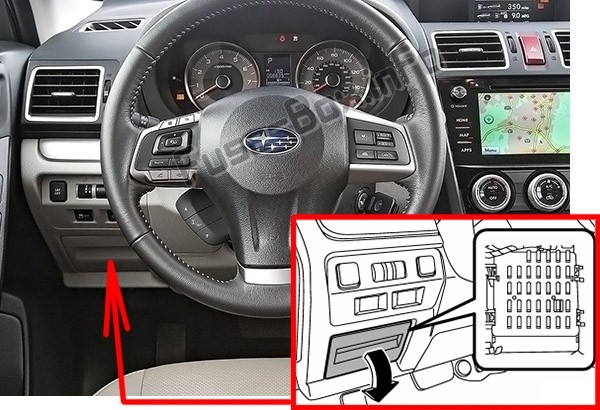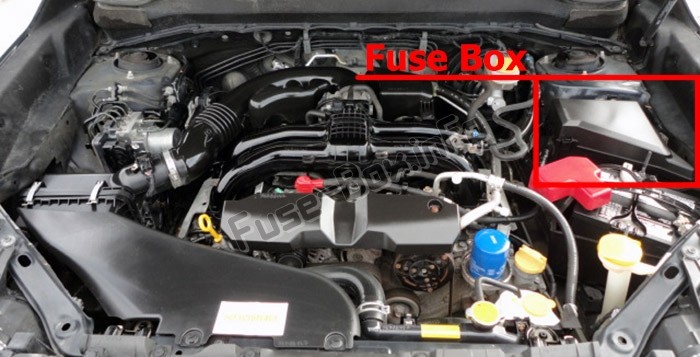Understanding your 2014 Subaru Forester’s fuse box is crucial for maintaining its electrical system. Whether you’re diagnosing a problem with your OBD2 port or other electrical components, knowing the fuse locations and their functions can save you time and hassle. This guide will walk you through the fuse box locations in your 2014 Subaru Forester, focusing on fuses relevant to the OBD2 system and other important circuits.
Fuse Box Locations in the 2014 Subaru Forester
Like most vehicles, the 2014 Subaru Forester has multiple fuse boxes. For easy access and comprehensive coverage, these are strategically placed in two main locations: the passenger compartment and the engine compartment.
Passenger Compartment Fuse Box
The primary fuse box you’ll likely need to access is located inside the passenger compartment. Specifically, it’s positioned to the left of the steering wheel, behind a protective cover. This location is convenient for accessing fuses related to interior functions and some essential vehicle systems.
Engine Compartment Fuse Box
The second fuse box is situated in the engine compartment, typically closer to the battery and other engine components. This fuse box generally houses fuses for high-current circuits and systems directly related to the engine and drivetrain.
2014 Subaru Forester Instrument Panel Fuse Box Diagram
The instrument panel fuse box is crucial as it contains fuses for many of the car’s electronic systems, potentially including circuits related to the OBD2 port. Below is a diagram and table detailing the fuse assignments for the instrument panel fuse box in the 2014 Subaru Forester.
Instrument Panel Fuse Assignment (2014, 2015, 2016)
| Fuse # | Amp Rating | Circuit |
|---|---|---|
| 1 | 20A | Trailer hitch connector |
| 2 | Empty | |
| 3 | 15A | Door locking |
| 4 | 10A | Front wiper deicer relay |
| 5 | 10A | Combination meter |
| 6 | 7.5A | Remote control rear view mirrors, Seat heater relay |
| 7 | 15A | Combination meter, Integrated unit |
| 8 | 15A | Stop light |
| 9 | 15A | Front wiper deicer |
| 10 | 7.5A | Power supply (battery) |
| 11 | 7.5A | Turn signal unit |
| 12 | 15A | Transmission control unit, Engine control unit, Integrated unit |
| 13 | 20A | Accessory power outlet (center console) |
| 14 | 15A | Parking light, Tail light, Rear combination light |
| 15 | 10A | Luggage light, Keyless unit |
| 16 | 7.5A | Illumination |
| 17 | 15A | Seat heaters |
| 18 | 10A | Backup light |
| 19 | 7.5A | Daytime running lights |
| 20 | 10A | Accessory power outlet (instrument panel) |
| 21 | 7.5A | Starter relay |
| 22 | 10A | Air conditioner, Rear window defogger relay coil |
| 23 | Empty | |
| 24 | 10A | Audio unit, Navigation system (if equipped) |
| 25 | 15A | SRS airbag system |
| 26 | 7.5A | Power window relay, Radiator main fan relay |
| 27 | 15A | Blower fan |
| 28 | 15A | Blower fan |
| 29 | 15A | Fog light |
| 30 | Empty | |
| 31 | 7.5A | Auto air conditioner unit, Integrated unit |
| 32 | 7.5A | Clutch switch, Steering lock control unit |
| 33 | 7.5A | Vehicle Dynamics Control unit |


Identifying the OBD2 Fuse
While there isn’t a fuse explicitly labeled “OBD2” or “Diagnostic Port”, the OBD2 port’s functionality is linked to the car’s computer systems. Based on the fuse assignments for the 2014 Subaru Forester, fuse number 12 (15A), which protects the “Transmission control unit, Engine control unit, Integrated unit,” is highly likely to be related to the OBD2 system. The Engine Control Unit (ECU) is critical for OBD2 operation.
Additionally, fuse number 20 (10A), “Accessory power outlet (instrument panel),” might also play a role, as the OBD2 port requires power to function. If your OBD2 port is not working, checking both fuse #12 and #20 in the instrument panel fuse box would be a good starting point.
2014 Subaru Forester Engine Compartment Fuse Box Diagram
For completeness, and in case your electrical issue extends beyond the interior systems, here’s the engine compartment fuse box diagram for the 2014 Subaru Forester.
Engine Compartment Fuse Assignment (2014, 2015, 2016)
| Fuse # | Amp Rating | Circuit |
|---|---|---|
| A | Main fuse | |
| 1 | 30A | ABS unit, Vehicle Dynamics Control unit |
| 2 | 25A | Main fan (cooling fan) |
| 3 | 25A | Sub fan (cooling fan) |
| 4 | Empty | |
| 5 | 25A | Audio |
| 6 | 30A | Headlight (low beam) |
| 7 | 15A | Headlight (high beam) |
| 8 | 20A | Back-up |
| 9 | 15A | Horn |
| 10 | 25A | Rear window defogger, Mirror heater |
| 11 | 20A | Fuel pump |
| 12 | 20A | Continuously variable transmission control unit |
| 13 | 7.5 A | Engine control unit |
| 14 | 15A | Turn and hazard warning flasher |
| 15 | 15A | Tail and illumination relay |
| 16 | 7.5 A | Alternator |
| 17 | Empty | |
| 18 | Empty | |
| 19 | 15A | Headlight (low beam – right hand) |
| 20 | 15A | Headlight (low beam – left hand) |
Important Notes on Fuses:
- Always consult your 2014 Subaru Forester owner’s manual. Fuse diagrams and assignments can sometimes vary slightly based on trim level and specific vehicle options. Your owner’s manual is the most accurate source of information for your vehicle.
- Use the correct amperage fuse. Replacing a fuse with one of a higher amperage can cause serious damage to your vehicle’s electrical system and potentially create a fire hazard.
- Diagnose the root cause. If a fuse blows repeatedly, it indicates a problem in the circuit. Simply replacing the fuse without diagnosing the underlying issue will likely lead to the fuse blowing again.
By understanding the fuse box locations and diagrams for your 2014 Subaru Forester, you can confidently troubleshoot and address minor electrical issues, including problems related to your OBD2 port. Remember to always prioritize safety and consult your owner’s manual for the most accurate information.
